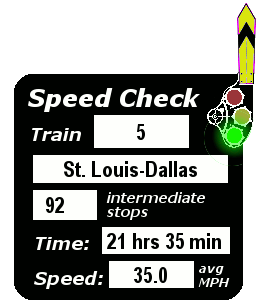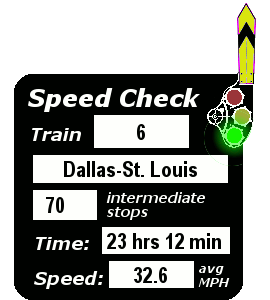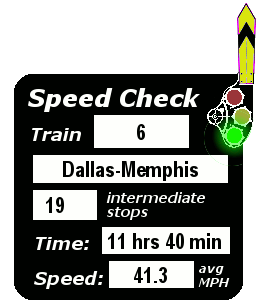ST. LOUIS SOUTHWESTERN RAILWAY
LINES
PASSENGER TRAIN EQUIPMENT
MORNING STAR—Trains 5 and
6.
AIR-CONDITIONED Combination Sleeping-Dining-Chair Cars between St.
Louis and Pine Bluff.
De Luxe AIR-CONDITIONED Chair Cars between St. Louis and Dallas.
De Luxe AIR-CONDITIONED Chair Cars between Memphis and Dallas.
AIR-CONDITIONED Dining-Lounge Cars between Memphis and Dallas.
Note—Train
No. 5 stops at any station for revenue passengers to, from or beyond
Memphis, Shreveport and Mt. Pleasant.
Note—Train
No. 6 will stop at any station between Dallas and Texarkana to
discharge passengers holding foreign line tickets from beyond Dallas.
PRIDE OF THE COTTON BELT
The Morning
Star
ULTRA-MODERN CHAIR CARS
AND DINER-LOUNGE
DeLuxe Air-Conditioned Coaches and Pullman-Cafe Cars Between
St. Louis and Pine Bluff.
Air-Conditioned Coaches and Diner-Lounge Cars Between Memphis and
Dallas.
Daylight Runs Through the Arkansas Rice Fields
FAMOUS COTTON BELT
COOKING ON
"MORNING STAR" AND "LONE
STAR" TRAINS
Talk to
Nearest Cotton Belt Agent
"THE PEOPLE'S TRAIN TO THE PEOPLE'S CAPITAL"











Yours truly was once present at the annual stockholders' meeting of a major Class 1 railroad. The topic of discussion was the ongoing attempt by another carrier to gain entry to a lucrative traffic area that the railroad in question controlled, and the regulatory interventions and legal briefs that said Class 1 was filing in the hopes of keeping the competitor out. One stockholder, though, raised the question from the floor that if the competitor did overcome all of the legal and regulatory hurdles that this carrier was trying to lay in their way and got to the point where it was a matter of "just turning dirt," whether the Class 1 would consider granting trackage rights so that "we can glean at least a little bit out of all that traffic." The president and CEO replied sagely, "I see you know your railroad history."
Trackage rights agreements were (and still are) popular. They save the tenant railroad the major capital costs of construction and right-of-way acquisition; they give the landlord railroad a way to manage the presence of and often to keep a dangerous competitor in a permanent secondary position as well as to glean "just a little bit" of revenue in usage rights and maintenance fees from traffic which otherwise would have gone glimmering. When Santa Fe decided that come hell or high water it was going to gain its own entrance to San Francisco, Southern Pacific was motivated to grant trackage rights on the critical "Tehachapi Loop" segment between Mojave and Bakersfield. Rock Island used Union Pacific trackage from Limon to gain entry to Denver. In more recent days, just a few years ago four local refineries in the Bayport area near my home town of Houston sought an agreement with BNSF to construct a branch line and break Union Pacific's monopoly on their rail transport. UP fought like a tiger—environmental impact filings, regulatory interventions, quiet support for grassroots NIMBY organizations—but when BNSF gained Surface Transportation Board approval to begin construction, almost as if by magic Union Pacific found it in their hearts to offer trackage rights, even though they had been arguing for years that there was "insufficient capacity".
In the early 20th century Missouri Pacific was sitting in the catbird seat for rail traffic between the Southwest and the East via St. Louis. Their fast passenger main served the Arkansas capital of Little Rock and had the most direct routing into the city of St. Louis, while at the same time they had a fast freight route which diverged at Poplar Bluff and crossed the Mississippi on a bridge which the MoPac owned and controlled at Thebes before heading north along the Illinois side of the river, avoiding the grades and curves of the line through the Ozarks, to East St. Louis. There traffic could be directly interchanged with the eastern railroads bypassing the congestion and bottlenecks of the T. R. R. A. bridges in St. Louis. The Cotton Belt system, building north through Arkansas, managed to negotiate trackage rights over this freight main into East St. Louis. This allowed them to share many of the advantages MoPac enjoyed for freight traffic, although any passenger traffic had to enter through the St. Louis congestion from the east. The timetables tell the tale; in this same edition of the Official Guide Missouri Pacific's best service from Dallas to St. Louis, the Sunshine Special, shows an en route time of 16 hours southbound and 16˝ hours northbound. For freight traffic, though, Cotton Belt's all-merchandise train The Blue Streak actually edged Missouri Pacific's best freight time from Dallas to the East St. Louis gateway.
Enter Southern Pacific. They had bested Texas & Pacific, which was originally chartered to operate the southern transcontinental route as far as Yuma, and won their own route from the West Coast into New Orleans in 1883. With their share of the Overland Route they had the only fast connection from northern California to the East, and in the joint R. I.-S. P. Golden State Route they had excellent connections from southern California to Memphis, Kansas City and Chicago as well as an adequate connection to St. Louis. Was that good enough for "The Octopus?" No, They Wanted It All...and if that meant starving their putative partner Rock Island into multiple bankruptcies and eventual liquidation, that was Just Too Bad. In the Cotton Belt system S. P. saw a potential merger partner which would augment their system end-to-end, allowing them to route California freight over their own rails all the way into the important gateway cities of Memphis and St. Louis. While the Interstate Commerce Commission held short of allowing a formal merger, in 1932 they did give Southern Pacific the green light to purchase, control, and manage the Cotton Belt system, resulting in a merger in all but name.
Southern Pacific and Cotton Belt's main focus was and always would be freight. However, in May of 1941 Southern and Norfolk & Western would combine on a new streamliner from the nation's capital to the gateway city of Memphis which became the Tennesseean. Cotton Belt and their S. P. masters saw the opportunity in play for a share of the passenger traffic to and from Dallas and the new train. They rushed this collection of equipment into service...the accompanying advertisement touts, and I quote: "Ultra-Modern Chair Cars and Diner-Lounge." Reading between the lines...if the equipment was all-new the advertisement would probably have said so, and I have never seen Cotton Belt listed in the secondary literature as the operators of a true streamliner. This makes me believe that the "ultra-modern" equipment was in fact heavyweight cars from the 1920s which had been freshened up with new paint, upholstery, and of course air-conditioning...although I remain open to correction.
[Edit 2014-12-06] And correction has come: A Google Books scan of Cotton Belt Locomotives by Joseph Strapac reveals that four years earlier, in 1937, Cotton Belt did indeed purchase ten new semi-streamlined coaches from Pullman; this became the nucleus of their Morning Star fleet. It appears, however, that most of the rest of their equipment was steel heavyweight cars which had been purchased secondhand and refurbished.